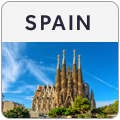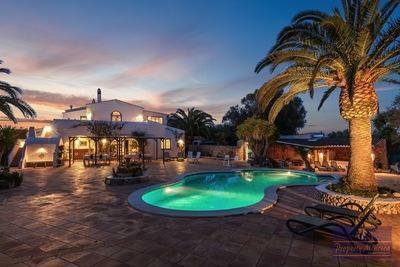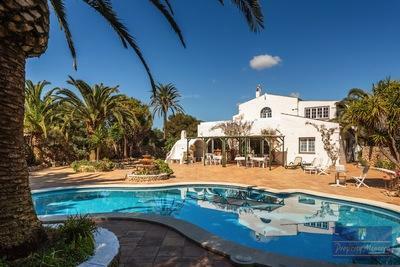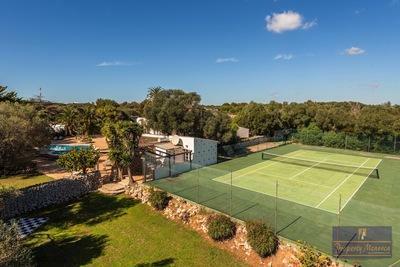Es Castell, Menorca, Balearic Islands, Spain
- PROPERTY TYPE
Detached Villa
- BEDROOMS
12
- BATHROOMS
10
- SIZE
7,535 sq ft
700 sq m
Key features
- 12 BEDROOMS
- 10 BATHROOMS
- HEATING
- POOL
- TENNIS COURT
Description
Sitting pretty on the world's second-largest natural harbour (5km long), Mahon is an unusual blend of Anglo and Spanish characteristics. The British made it the capital of Menorca in 1713, and the influence of their almost-100-year presence (the island reverted to Spanish rule in 1802) is still evident in the town's architecture, traditions and culture.
Built atop the cliffs that line the harbour's southern shore, the town is a bright, breezy, easy-going place. Although some older buildings still remain, the majority of the architecture is in the restrained 18th-century Georgian style (note the sash windows and, as the Menorcans say to this day, boínders - bow windows).
Menorca's southern flank tends to have the better beaches - and thus the greater concentration of development. The jagged coastline is occasionally interrupted by a small inlet with a sandy beach, backed by a cluster of gleaming-white villas, largely small-scale and in Moorish-Mediterranean style.
The coast south of Mahon has a sprinkling of pretty coves, the island's top winery and mysterious archaeological sites that delight anyone with an interest in prehistory.
The Me1, Menorca's main road connecting Mahon and Ciutadella, runs east-west through undulating farmland, passing by the sun-bleached villages of Alaior, Es Mercadal and Ferreries. Along the way smaller roads branch off towards the beaches and resorts of the north and south coasts.
Many of Menorca's most significant archaeological sites are signposted off the main road.Inland from Es Grau and separated from the coast by a barrier of high sand dunes is S'Albufera, the largest freshwater lagoon in the Balearics. Home to many species of wetland birds, it's also an important stopover for migrating species. The lagoon and its shores form the 'nucleus zone' of Menorca's Biosphere Reserve, a natural park protected from the threat of development.
Menorca, Natural Biosphere Reserve
UNESCO recognized Menorca as a natural biosphere reserve on 8th of October of 1993, taking into consideration its high degree of compatibility achieved between the development of economic activities, expenditure and the conservation of a heritage and landscape that has maintained, and continues maintaining today, an exceptional quality. Menorca has a very rich and traditional rural countryside. It hosts a remarkable diversity of Mediterranean habitats in which rare animal species and plants live, some of them in threat of extinction.
UNESCO recognized Menorca as a natural biosphere reserve on 8th of October of 1993, taking into consideration its high degree of compatibility achieved between the development of economic activities, expenditure and the conservation of a heritage and landscape that has maintained, and continues maintaining today, an exceptional quality. Menorca has a very rich and traditional rural countryside. It hosts a remarkable diversity of Mediterranean habitats in which rare animal species and plants live, some of them in threat of extinction.
Around the world it there are more than 400 biosphere reserves where the concept of the sustainable development is being tried and tested. They are places in which human activity is developed alongside the vital conservation of natural resources and cultural heritage. Menorca is a member of the Spanish Network of Biosphere Reserves and maintains contact with other assigned biosphere reserves in Program Man and Biosphere (MaB Program) of UNESCO.
The Consell Insular of Menorca, the institute responsible for the reserve, has opted for a sustainability programme so that future generations of residents and visitors can continue enjoying the natural resources and beautiful countryside. For this reason, every project is studied carefully in order to maintain the quality of life and the environmental standards which merited the declaration of UNESCO. As a natural biosphere reserve, these are the aims of Menorca:
To favour the conservation of activities that maintain the traditional countryside and to avoid any measures which pose a threat. For this reason Menorca has an Insular Territorial Plan (PTI), that classifies and protects land based on sustainability and regulating urban development.
To reinforce the conservation of natural eco-systems and native fauna and flora if they are at risk. To this end campaigns are carried out to eradicate invading flora and protect threatened species and specific habitats.
To widen knowledge of natural and cultural interest. For this reason investigations are carried out on archaeological and natural heritage.
- To define strategies of sustainability on a local scale. To this end each municipality has its Local agenda 21 and its own Plan of Environmental Action.
To environmentally manage the coast and its beaches, which form such an important part of the tourist activity, by protecting the marine and dune eco-systems. For this manual cleaning is prioritized and the occupation of beaches is regulated.
To diminish the environmental impact of the daily human activities. All waste is separated and processed accordingly; organic, everyday refuse, paper, glass and packaging.
To become an outdoor sustainability laboratory. For this reason the Social-Environment Observatory of Menorca has been created (OBSAM), which collects and analyses all information relevant to the biosphere reserve.
With the collaboration of Menorcan society, some NGOs and local businesses, Menorca is carrying out development strategies to benefit from its natural beauty but also to preserve it. In order to continue making these aims a reality we also need the support of our visitors, as together we can truly help to make development possible with the utmost respect for our environment.
History of Menorca
Menorca has been, from prehistory to very recent times, a crossroad point for many different cultures because of its strategic situation in the centre of the western Mediterranean. It has been considered both a port of call and a place of refuge by these different races. They have left the island a rich historical legacy.
Menorca has been, from prehistory to very recent times, a crossroad point for many different cultures because of its strategic situation in the centre of the western Mediterranean. It has been considered both a port of call and a place of refuge by these different races. They have left the island a rich historical legacy.
Human presence on the island can be traced back from the early Bronze Age (2000 AD), called the pre-talayotic period. Towards 1400 AD these inhabitants built huge stone constructions known as talayots, this era encompasses the richest period of island pre-history, and its most exceptional monument was the taula.
In the year 123 AD Menorca became part of the Roman empire, which transformed the talayotic villages and gave rising power to the three cities built on harbours: Mago (Maó), Jamma (Ciutadella) and Sanisera (Sanitja).
After the decline of Rome - like the rest of the Balearic archipelago - Menorca suffered successive invasions by vandals and Byzantines, until at the beginning of the X century it became part of Islam, initially ruled by the Emirate of Córdoba and later by the Tarifa of Denia.
After almost 400 years of Muslim domination, in 1287 the christian king Alfonso III the Liberal conquered Menorca and placed it under the rule of the crown of Aragón and then the kingdom of Majorca. During this period from the XIII to the XVIII century, and which included the gothic and baroque era, the island hoarded the most important jewels of artistic and architectonic heritage.
Nevertheless it was this stage, specifically during the XVI century, that Menorca lived its most tragic moments in history, with incessant invasions by pirates who caused huge unrest and suffering amongst the inhabitants, and which ended with the destruction by the Turks of Maó in 1535 and Ciutadella in 1558, leaving the island on the verge of total abandonment.
In the XVIII century Menorca was transformed once again as a result of European events and this time, due to the the War of Succession, it fell into English hands in 1713. The island remained in their power for the next hundred years with the exception of some brief periods of French and Spanish rule. During this time the English reinforced the coastal defenses and built important public buildings.
The XIX and XX centuries were equally multinational due to the continuous arrival of foreign troops to the port of Maó, which was a free port for the first few years. In this period the Lazareto and the Fortress of Isabel II in La Mola were both built in the Port of Maó. And then, during the XX century, Menorca was heavily involved in the Spanish Civil War from 1936 1939.
The XX century saw the development and success of many different industries on the island, but from the 80's tourism became the primary source of income and work. This period also saw the transition of democratic progress with the development of independent local institutions and island-government.
Towns
Menorca has a population of 67,000 inhabitants, concentrated in its eight municipalities: Maó, the administrative capital of the island, Ciutadella, the old capital, Alaior, Ferreries, Es Mercadal, Es Castell, Sant Lluís and Es Gran Migjorn.
There are three other villages; Sant Climent, Llucmaçanes and Fornells, the first two are in the municipality of Maó and the latter is in Es Mercadal. Maó in the east and Ciutadella in the west, are the two most populated towns of the island.
Location
Menorca is about one hour's flight from most Spanish cities and two from the main European cities. This makes for a perfect and easily accessible holiday destination.
Menorca has always been a stop-off point for many different cultures. Since prehistory they have sought shelter and refuge on our island, so strategically located and with the largest natural harbour in the heart of the Mediterranean. Each of these different cultures has left an important historic legacy, of which and we are very proud. Historians and archaeologists look on the island as a true open-air museum, and marvel at the wealth of heritage on such a small island.
Menorca is 702 kilometers square with 216 kilometers of coast. The maximum distance between two points is of 47 kilometers, between Ciutadella and Maó. The coast of Sant Lluís, on the Eastern side of the island, is the first point in Spain to see the sun rise.
Geologically the island is divided into two symmetrical but very different halves: the north, with its wild and rugged coastline and sparse vegetation, stunning beaches of golden sand looking out to small rocky islands and; and the south, with its soaring limestone cliffs, deep ravines carved out by the water and secluded white sandy coves surrounded by pines. The highest point on the island is Monte Toro, at 357 meters above sea-level.
Mediterranean Menorca
Menorca is a small piece of paradise within the western Mediterranean, a pearl bathed by calm seas and sheltered by a gentle climate. An unending range of colours melt into each other: blue skies, turquoise seas, dark green woods, brown rocks, white beaches.
Along the 216 km of coastline there are over 70 beaches and coves, with fine white sand along the south and reddish tones along the wilder north. The geological variety makes it an area of undoubted beauty with stark cliffs and gently sloping beaches. Nautical traditions in the ports still exist as a livelihood for many people, and as leisure for others. Menorca exists turned towards the sea, as the various lighthouses dotted along the coastline remind us. The whole landscape welcomes visitors with open arms Families will find ideas and facilities to enjoy holidays with children. Couples and friends can stay in 'adults only' accommodation and finish off a day spent on the beach or exploring by making the most of the local nightlife.
Natural
Do you think that Menorca only offers sun, sandy beaches and crystal-clear water? Don't be deceived - there's a lot more than that to the island. This is an exceptional place to actively explore. We have natural parks, a rich cultural heritage, delicious local products and cuisine for you to discover. We have stunning beaches, soaring cliffs, tiny islands and marine reserves teeming with life. There are so many ways to enjoy our coastline so where would you like to start?
And if you can drag yourself away from the clean sea-breeze and gentle waves, you won't be disappointed by our countryside. You can walk in so many beautiful spots where the natural habitat is unspoiled - there are countless lanes, valleys and country tracks where you feel at one with nature.
There are several Activity Holiday companies on the island who can offer you a great professional service . They'll help you choose your activity and give you all the relevant guides and information.
Cultural
Menorca's key position in the Mediterranean has been the envy of many different cultures - the Arabs, Romans, British and French all fell in love with the island and left their mark. Discover Menorca's culture - the fascinating talayotic monuments, the legacy of the British, its cuisine and so much more?
Slow
Time in Menorca has a different meaning: it has its own pace, a slow and serene tempo, in harmony with the setting and the scenery. Menorca is a 'Slow' destination. It has been so long before the term was coined, relating as it does to the way of life here, asserting the island's philosophy. The island has forged its individuality at a slow pace, a way of life that it now shares with people who come here.
Declared Biosphere Reserve in 1993, the island is a haven of peace; a place to find oneself, in which to listen to the silence. These lands and their inhabitants acknowledge that time has its own pace, with no attempt to dominate it. They have adapted their pace and now reap the benefits: Menorca Slow. Come to Menorca for a different approach to your holiday, an experience that brings you in close contact with nature. It is a superlative Slow destination.Find out for yourself by trying the local cuisine, by staying in accommodation in rural areas, by using the range of health and beauty treatments on offer or by spending time on your hobbies such as photography or painting in the open air.
Take your time, relax and enjoy.
Menorca's Water Sports centre
Menorca offers a wide range of you a wide range of ways to enjoy your holiday. Menorca's Water Sport Centre specialize in nautical holidays, and we aim to ensure that with our help you have everything that you need to have a great time.
Menorca offers the best of water sports - from scuba-diving, windsurfing, water-skiing and kayaking to chartering a sailing or motor-boat. We can also arrange golf, adventure sports and spa treatments.
Menorca was declared a Natural Biosphere Reserve by UNESCO in 1993, within its 'Man and Biosphere' programme. This recognition means that nearly half the island is protected by conservation laws which ensure an impressive environmental balance. The Law of Natural Areas encompasses nineteen zones.
Menorca's Water Sport Centre endorses sustainable tourism in accordance with our Natural Biosphere Reserve. Please help us to keep Menorca just as it is during your stay - a natural paradise!
Gastronomy Product Club
The Gastronomy Product Club was set up in Menorca to offer you a series of high added value experiences. Across Menorca, restaurants, producers, artisans and many others have joined forces to transform the island's attractions and enhance them to meet your expectations.
Member establishments along the four Routes (Cheese, Wine, Traditional Recipes and Seafaring Gastronomy) have committed to adhering to strict quality standards and requirements. In all the places mentioned here you'll find top quality local products prepared with loving care and displayed in surroundings that won't disappoint you.
Belonging to the Product Club sets high quality standards for restaurants, resulting in a better service for visitors. Plus, the Product Club enables us to preserve, display and publicise Menorca's gastronomic and cultural heritage, two of our best assets.
Activities in Menorca
Kayaking
Windsurfing
Sailing
Scuba-diving
Boat-hire
Boat trips
Stand up paddel
Jet-ski information
Walking
Cycling
Horse-riding holidays
Birdwatching
Sports Events
Golf
British Route
Talayotic Route
Museum Route
Religious Route
Ethnological Route
Fortified Route
Handcrafts
Gastronomy Routes
Fiestas
Towns
Cultural Events
Es Castell, Menorca, Balearic Islands, Spain
NEAREST AIRPORTS
Distances are straight line measurements- Menorca(International)3.7 miles
- Palma de Mallorca(International)85.4 miles

Advice on buying Spanish property
Learn everything you need to know to successfully find and buy a property in Spain.
About the agent
My name is Andy Tysoe and I came to Menorca in 1999. I immediately started working in Property Sales and have done so ever since.
I started "Property Menorca" in 2005 and thoroughly enjoy the challenge of running my own business.
In 2007 I completed the Spanish Real Estate Agency qualification and became the only Englishman in Menorca to hold the professionally recognized "Agente de la Propiedad Inmobiliaria" (API). Always make sure you deal with an API!
I currently live nea
Notes
This is a property advertisement provided and maintained by Property Menorca, Menorca (reference 1948) and does not constitute property particulars. Whilst we require advertisers to act with best practice and provide accurate information, we can only publish advertisements in good faith and have not verified any claims or statements or inspected any of the properties, locations or opportunities promoted. Rightmove does not own or control and is not responsible for the properties, opportunities, website content, products or services provided or promoted by third parties and makes no warranties or representations as to the accuracy, completeness, legality, performance or suitability of any of the foregoing. We therefore accept no liability arising from any reliance made by any reader or person to whom this information is made available to. You must perform your own research and seek independent professional advice before making any decision to purchase or invest in overseas property.



